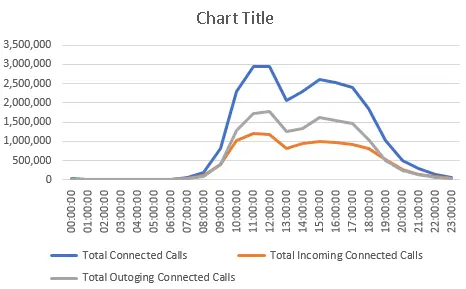For every successful company, sales are the most crucial aspect that drives the business. However, the pressure to generate an ambitious sales quota month on month is endless stress. Sales is a high-focus department that works with multiple techniques and strategies to touch desired targets. One such OG yet effective approach is cold calling.
But what is a cold call? Cold call means making an unsolicitedunsolicitated call or visiting prospects to sell a product or service. Studies have proved that organisations that don't incorporate cold calling in their sales process experience 42% lesser growth.
Companies appoint telecallers and calling teams to cold call prospects and use a call monitoring system to keep a track of their progress.
Telecaller should have adequate knowledge of prospects and markets to succeed. In this blog, we’ll highlight some important aspects that can help you as a telecaller in India. So, let’s begin.
When is the best time to make cold calls?
The major challenge telemarketers face is connecting with potential clients. Evaluating the best time to make a cold call depends on various factors. These factors revolve around who are your target audience, your demography and your daily schedule.
As a telecaller, to evaluate the right time to make a cold call, you should address the following:
1) Is your target audience working from 9 AM to 5 PM?
2) Are they students busy with classes at various times of the day?
3) Are they parents who are busy taking care of their children before 9 AM and after 5 PM?
Knowing your prospect and their daily schedule is the primary thing you should work on. Anticipating your customer's schedules can help you determine the right time to make the cold call, thus increasing the chances of converting potential leads into customers.
According to the study by Callyzer, the best time to contact your prospect is between 10:00 AM to 12:00 PM. Followed by 3:00 PM to 5:00 PM. This statistics is derived from Callyzer’s database of 4+ CR call logs.

With the right time to contact your prospect, phone etiquettes are equally essential to be successful at cold calling. Before jumping into a sales pitch, you should always ask if the customer is available for the conversation. Also, make sure that your background is not noisy.
Always practice healthy cold call habits to maintain professionalism and effectively pitch your product or service.
Steps to successfully pitch your product or service on the call.
Despite your best efforts to time your call, you’ll still face objections and rejections. Still, here are a few steps you should add to your calling process to effectively pitch your product or service:
Step 1: Know Everything About Your Product
Research indicates that 73% of consumers seek sales associates with complete product knowledge. It is proven that telemarketers with comprehensive product knowledge make more sales.
Present-day buyers have complete knowledge of the market because of the information on the internet. It is just impossible to trick them into buying anything. It is imperative to win their trust. And it is only possible when you know your product or service inside-out. When you answer their out-of-box questions about your product or service, it leaves a lasting impression on your potential customers.
As a telecaller, you should perceive that you are the ambassador of your product or service. This approach will help you gain more sales.
It would be best if you understood how your product or service operates. What are the core functionalities of your product? How can your product or service help consumers solve any problem? Do an in-depth study of all your product demo videos if available. Also, go through support documents. Try to understand each feature and its utilization.
To be top-notch at your game, you should have a precise answer to every question, like:
1) How does your product or service help to solve a problem?
2) Is your product or service customizable?
3) What is the cost?
4) Will I receive support for this product or service?
5) How is your product or service different from your competitors?
You need more than just knowing your product name and a few features your marketing department gave. You should dig deeper and familiarize yourself with information like things that separate your product or service from your competitors. Get in-depth knowledge about product warranty and how your product or service can make your consumer's life easier.
You get ample confidence when you completely understand and know what you are selling. It also helps you understand your customer's pain points and quickly map how to market your product or service.
Step 2: Research Your Prospect Before Calling
One of the essential tips for any telesales person is to prepare well in advance before approaching a prospect. You must know your target audience and their requirements.
As the saying goes, "Show them, you know them". Being well-prepared for your pitch and having enough knowledge about your lead shows competency. It adds value to your customer interaction, making you sound more confident.
When you gather all the necessary information related to your prospect, it becomes easier for you to connect with them and convert them into forever clients. Understanding your consumers shows that you are interested in them, leaves a good impression, and helps you maximize sales.
Step 3: Probing the Prospect's Pain Points
A prospect will only listen to your pitch if you have a solution to solve their problem. You can go far if you understand the prospect's pain points and discuss how your product or service can make a difference. Explain to your customers how your product or service can directly benefit them.
To get into details about your prospect's pain points, include the following questions in your conversation:
1) Please help me understand your business cycle.
2) What are your expectations from our product or service?
3) What are the hurdles you face that concern you the most?
4) Do you have budget constraints?
A telecaller needs to listen to all the answers actively. Most of the time, salespeople are busy pushing their sales and don't concentrate on what prospects are saying. You can understand your prospect's pain points by engaging in a healthy conversation.
Your sales pitch will work wonders when you show your prospect that you understand their hurdles and that the product or service you offer can solve their problems.

Step 4: Have a Solid Opening — Stand Out from Unenthusiastic Callers
As it is said that the First impression is the last. It is essential to have a solid opening to your pitch. A solid opening will help you stand out from other telecallers. More often than not, when you call a prospect who holds a senior-level position, a PA or secretary will answer you. This is the time when you can get creative.
If it's your first approach, you can tell their gatekeeper(PA or Secretary) that you are calling regarding a "New Business" or "About Client Acquisition Progress". Think outside the box about how you can make this work with the choice of words. Your solid opening will make a difference between being connected to the prospect and never having your message delivered.
Let's assume your call is transferred, and your prospect picks up. Start your conversation with formal greetings, followed by "I'll keep it brief as I appreciate you are busy. Have you got 30 seconds for me to explain the nature of my call?"
It is crucial to acknowledge that a prospect's time is limited and ask for their permission to continue the conversation. This is an excellent approach to start.
Step 5: Talk about them (Not your product)
Ask How they are, if it is the right time to talk, and introduce yourself.
The best salesperson can sell the product without almost ever having to talk about the product. Understand that as an efficient salesperson, prioritizeprioritise your prospects rather than your product.
Always be an active listener to your potential consumer. Be humble and ask how they are. Or if it is the right time to talk? Rather than rushing into explaining your product.
As you start the conversation, introduce yourself and gradually build the conversation. Establish trustful relationships with your prospect and then talk about the product or service when they are ready.
Step 6: Practice active listening
If they say they don't need to, move to the next. Be respectful of their time.
One significant aspect a cold caller must imbibe is to be a good listener. Every prospect wants to be actively heard. This makes them feel that you are a good listener. There will be instances when the client doesn't need the product or service you are offering. Please respect their decision and move on to the next lead without getting personal or losing your confidence. As a good telecaller, you should have thick skin to handle rejections.
Step 7: Sell the solution, not the product
Let me burst your bubble by telling you that your prospects are not interested in how efficient your product or service is; they are more interested in knowing how your product can improve their lives.
For instance, if you are selling a laptop that incorporates hundreds of valuable features and you waste your time explaining the proficiency of the features. Your prospects will only be interested in something other than the boring pitch. Instead, if you tell them that this device can save their time and help them do smart work instead of laborious work, they will be more engaged in the conversation.
Always address the prospect's pain points to engage them in the conversation. This approach can make a convincing sales pitch.

Step 8: Ask open-ended questions
For a successful telesales person, it is essential to understand that in any cold call, the prospect must do 70% of the talking. This makes them feel that they are being actively heard.
According to a recent study by HubSpot, 69% of buyers want telesales people to listen to their needs.
Asking open-ended questions is an essential part of cold calling because it is an excellent method to exhibit the prospect that you are a great listener. More the prospect talks, the more information they offer, allowing you to get valuable insights that will be helpful for you to understand their pain points.
Here are some examples that you can include in your script:
1) What is your business cycle?
2) How are you generating new leads?
3) What are the major hurdles that you face in your business?
These questions depend upon your product or service. However, including open-ended questions can do wonders for you.
Step 9: Anticipate objections
One of the toughest challenges for cold calling is dealing with objections. It can break your confidence into pieces. But on the brighter side, objections are far better than silence.
See each objection as an opportunity to shine.
There is a big difference between objections and rejections. A talented telecaller will always come up with innovative solutions to deal with objections. It is always helpful to make a call with positivity but be smart enough to tackle objections coming.
Let's have a look at a few common objections that come your way. We will also discuss a few strategies to overcome them.
Objection 1: "Can you send me mail?"
This is the most common objection that every sales rep has experienced. A common approach to handling this objection is to reply, "Yes, of course - I appreciate you might be busy at the moment. Is there a better time to call you back?"
This might help you get a scheduled time to connect with your prospect again.
Objection 2: “We are already using(competitor’s product or service)”
This is a tricky objection to handle. You can handle this objection by enhancing your strong features, which your competitor might not provide. Uncovering a prospect's pain points is a great way to overcome objections.
Objection 3: I don't have time - I'm busy
This is the most common yet complex objection. The trick to answering this one is to figure out if the prospect is actually busy or just brushing you off because they want to ignore the call.
Also, remember that most of the prospects have trust issues with salespeople. If you feel the prospect is just objecting to this to keep you away because of trust issues, reply by saying," No worries, I will be real quick - I promise". If they agree, you have grabbed an opportunity, and if they don't, ask if there is any reasonable time for a callback.
Never get disheartened by any objections. It's your job to respond to cold calling objections to make your prospects believe it's worth their time talking to you.)
Step 10: Follow up after the Call.
It is proven that 80% of the deals require at least five follow-ups or more to be a successful deal. Thus, every sales expert will agree that the follow-up stage is crucial. Follow-up after a call can be essential to confirm a deal. Follow-up can be through an Email or a call. Follow-up Email is a great way to stay connected with your prospect.
Follow-ups also make your prospects feel that you care about them. There are multiple ways to send a follow-up Email. Follow-up emails can be categorizedcategorised in different ways.
1) Looking forward to connecting with you - Follow-up Email sent to prospect after a cold call.
2) Writing to follow up on earlier conversations - Asking your prospect about the next step,
3) Should we continue or not - Ask your prospect if they are still interested in talking to you about the product or service.
Always remember that an extra call can make a difference between winning and losing a deal.

More Useful Cold Calling Tips
Speak in the Prospect's Language
Every business has its language. To be successful at selling, you should learn to speak in the prospect's language. Be attentive to how your prospects talk. Always remember that cold calling is a two-way communication that includes sharing information your prospects can understand and, more importantly, relate to and respond to.
Use Rejection as an Opportunity
This is the important first step to learning. Never ignore a rejection! Refrain from pushing your pitch when you sense a rejection during the cold call. This might sound needy to your prospect, and that isn't nice! Stay natural, calm and composed whenever you face a rejection. Please take it as a learning experience and have a positive attitude.
Under-promise and over-deliver.
When you over-promise and fail to deliver, you are losing your customers on a very high level. Always promise less than you can fulfill. When your customer's expectations are low, and then they deliver more than their expectations, they'll be blown up.
Let the customers sell themselves.
Never push your customers to buy your product or service. This is the worst you can do to your customers. A great salesperson will answer customer questions efficiently, understands and addresses buyers' pain points and lead them to convince themselves that the product is right for them.
Mimic your customers—in a nice way.
To be an excellent salesperson, you should identify and adapt your prospect's language. Always be attentive to the adjectives your customers use and utilize the same in your pitch to invoke similar emotions in buyers.
Final Words
If you are starting as a Telecaller or have been doing this for decades, you need to understand that being Telecaller is a process of constant evolution. Sales is a never-ending process; you can only be effective or successful if you are competitive, persistent and patient.

